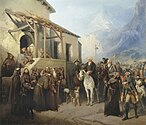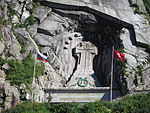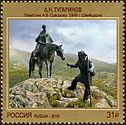Italian and Swiss expedition of 1799
This article needs additional citations for verification. (February 2022) |
| Italian and Swiss expedition | |
|---|---|
| Part of the Germany and Austria | |
| Result |
|
? Helvetes
? Polish
? Austrians
? Swiss rebels
Unknown killed and wounded
80,000 prisoners, 3,000 cannons, 200,000 guns[4]
The Italian and Swiss expedition of 1799
Preparations
The expedition was primarily planned by
Although by 1799 he was nearly seventy years old, Suvorov was one of the most competent and experienced commanders of the age.[
her son and successor, after the old soldier had the audacity to criticise the new imperial Infantry Code.[citation needed] He was only recalled after the Austrians specifically requested that he be appointed to command the combined Austro-Russian army to fight the French in Italy.[citation needed]
Order of battle
Russian forces
65,000 Russian troops participated in the expedition.[3] The Russian expeditionary force consisted of three corps.[3]
- The first corps was that of Russian general Brest-Litovsk, marching via Opole, the Moravian Gate, Prague, crossing the Danube west of Regensburg, and entering Switzerland in order to confront a French army near Zürich.[3] Its ultimate objective was to invade France through its weakly defended Alpine border.[3]
- The second corps went from Brest-Litovsk via Kraków and Krems to Vienna – where Suvorov joined the troops and assumed overall command – and then across the Brenner Pass via Brescia to Milan (at 1,650 kilometres from Moscow).[3]
- The third corps commanded by
Austrian forces

Strength: 148,663 (178,253 when garrisons are included) in August 1799[13]
French forces
- Army of the Danube (2 March – 11 December 1799; merged into the Army of the Rhine on 24 November 1799)
- Army of Naples (armée de Naples)
- Army of Italy.
- Strength: 53,581 (63,657 when garrisons are included) on 23 September 1799[13]
- Commanders:
- 12 March – 26 April 1799: General Schérer, as part of his overall command of the Army of Naples
- 27 April – 4 August 1799: General Moreau, as part of his overall command of the Army of Naples
- 5–15 August 1799: General battle of Novi
- 15 August – 20 September 1799: General Moreau
- 21 September – 30 December 1799: General Championnet
- Army of the Alps (created on 27 July 1799, merged into the Army of Italy on 29 August 1799).
- Commander: Jan Henryk Dąbrowski
Italian campaign
Taking command on 19 April, Suvorov moved his army westwards in a rapid march towards the
From
Moreau was relieved of command, to be replaced by

Swiss campaign

In 1798, Paul I gave
Outcome
Suvorov succeeded in rescuing his army 'by a brilliant but costly fighting march across the Alps into eastern Switzerland'.[2] He did not lose a single battle.[citation needed] However, the defeat Korsakov's army at the Second Battle of Zürich proved to be decisive: it destroyed any hopes of invading France and restoring the Bourbon monarchy, and along with the failed Anglo-Russian invasion of Holland, and rising tensions with Austria (which escalated during the Austro–Russian occupation of Piedmont), Tsar Paul I became so enraged that he pulled Russia out of the Second Coalition, and the Russian troops were withdrawn.[2] The tsar's decision to abandon the Coalition dismayed most Russian leaders.[18]
According to the conventional view amongst historians by the 1980s, Russia's withdrawal in late 1799 was crucial to the eventual collapse of the Second Coalition and the French final victory in March 1802.[2] However, Schroeder (1987) argued that '[t]he chances for an Austro–British victory were little worse without Russia than with it,' considering that Austria provided three-fourths of the land forces deployed to defeat France.[19] The main effect of Russia's defection on the Coalition was that Britain could no longer control Austria's actions as it pleased, and had to deal with Vienna as an equal partner.[18] Paul I attempted to forge a Russo–Prussian alliance in late 1799 and 1800 to punish Austria,[18] and by January 1801 his relations with Britain had also worsened so much that he was on the brink of invading British India with 22,000 Don Cossacks.[3] This plan did not materialise because tsar Paul I of Russia was assassinated in March 1801.[3]
Although the French military managed to overcome the Austro–Russian expedition, it made little immediate gain from it. By the end of 1799, the Army of Italy held almost the same position as Napoleon Bonaparte had found it in 1796, except that it now also controlled Genoa.[13]: 341 The army was in a desolate and impoverished state, with famine, lack of ammunition and horses, with bouts of desertion and mutiny as hungry soldiers sought to take food from civilians to survive.[13]: 342–343 The news that Napoleon had returned to France briefly prompted morale amongst the troops to rise, as he was still popular for his victories during the 1796–97 Italian campaigns.[13]: 343–344 But when the soldiers heard that Napoleon had committed the Coup of 18 Brumaire and made himself First Consul of the French Republic, French officers generally reported discontent and protests from the troops, especially from the Army of Italy which used to be under Napoleon's command, as many regarded the coup as a betrayal of the republican ideals they had been fighting for.[13]: 344–346 Nevertheless, when Napoleon reassumed command, he managed to retake control of northern Italy during the Marengo campaign (April–June 1800).[20]
Suvorov was recalled to Saint Petersburg, where he was promoted to the rank of Generalissimo, the fourth in all of Russian history.[citation needed] It was as a consequence of this campaign that Suvorov wrote Rules for the Conduct of Military Actions in the Mountains. He died in May 1800, having never fulfilled his greatest ambition – to meet Napoleon on the battlefield.[citation needed] A detailed account of the campaign was published in five volumes by Dmitry Milyutin in 1852–53.[citation needed] Suvorov remains vividly remembered in the parts of the Swiss Alps his army passed through. Even though his famished troops plundered the countryside bare and his campaign was ultimately fruitless, the general is venerated as a liberator from the occupying French. Plaques adorn nearly every spot where he ate or slept in the Alps; chairs and beds he used are preserved as exhibits.[21] A life-size equestrian statue was unveiled in 1999 on the St. Gotthard Pass.[citation needed]
List of battles

In art
-
Suvorov victorious at the Battle of Trebbia. Alexander von Kotzebue, 1889.
-
Suvorov in Milan. Adolf Charlemagne (d. 1901).
-
Suvorov at theSt. Gotthard Pass. Adolf Charlemagne (d. 1901).
-
Suvorov Crossing theDevil's Bridge. Robert Porter (d. 1842).
-
Suvorov's March across the Alps (1904 mosaic from the Suvorov Museum).
-
Suvorov Bidding Farewell to the Swiss People. Andrey Popov (d. 1896).
-
Monument to Alexander Suvorov and his fallen soldiers next to the Devil's Bridge, 1899.
-
1999 statue on the St. Gotthard Pass on 2016 postage stamp of Russia
See also
Notes
- ^ With Polish Legions
References
- ^ Suvorov 2023, p. 356.
- ^ a b c d e Schroeder 1987, p. 245.
- ^ ISBN 9780195161007. Retrieved 24 February 2022.
- ^ Suvorov 2023, p. 164.
- ^ ISBN 9789004122734. Retrieved 24 February 2022.
- ^ Schroeder 1987, p. 249.
- ^ Schroeder 1987, p. 258–266.
- ^ a b Schroeder 1987, p. 263–266.
- ^ Schroeder 1987, p. 249–250.
- ^ Schroeder 1987, p. 266–268.
- ^ Schroeder 1987, p. 268–269.
- ^ Schroeder 1987, p. 255.
- ^ a b c d e f g h Ramsay Weston Phipps, The Armies of the First French Republic and the Rise of the Marshals of Napoleon (1939), p. 335–338.
- ^ a b John Young, D.D. A History of the Commencement, Progress, and Termination of the Late War between Great Britain and France which continued from the first day of February 1793 to the first of October 1801, in two volumes. Edinburg: Turnbull, 1802, vol. 2, p. 220.
- ^ Latimer, 65
- ^ Latimer, 68
- ^ Furse, George Armand Marengo and Hohenlinden (2 vols 1903, facsimile edition Worley 1993 p.80)
- ^ a b c Schroeder 1987, p. 283.
- ^ Schroeder 1987, p. 282–283.
- ^ Michael Ray, Gloria Lotha (18 March 2020). "Napoleonic Wars § The Marengo campaign, The Danube campaign and Hohenlinden". Encyclopaedia Britannica. Retrieved 21 February 2022.
- ^ Nussbaumer, Hannes. "Wie ein russischer General zum schweizerischen Volkshelden wurde ('How A Russian General Became A Swiss Folk Hero)". Berner Zeitung (in German). Retrieved 19 September 2009.
Sources
- OCLC 19596006.
- Clausewitz, Carl von (2020). Napoleon Absent, Coalition Ascendant: The 1799 Campaign in Italy and Switzerland, Volume 1. Trans and ed. Nicholas Murray and Christopher Pringle. Lawrence, Kansas: University Press of Kansas. ISBN 978-0-7006-3025-7
- Clausewitz, Carl von (2021). The Coalition Crumbles, Napoleon Returns: The 1799 Campaign in Italy and Switzerland, Volume 2. Trans and ed. Nicholas Murray and Christopher Pringle. Lawrence, Kansas: University Press of Kansas. ISBN 978-0-7006-3034-9
- Dmitry Milyutin. The History of the War of Russia with France during the Reign of Emperor Paul I, vol. 1–9. St. Petersburg, 1852–1853.
- Schroeder, Paul W. (1987). "The Collapse of the Second Coalition". Journal of Modern History. 59 (2). The University of Chicago Press: 244–290. S2CID 144734206. Retrieved 22 February 2022.
- Latimer, Jon (December 1999). "War of the Second Coalition". Military History: 62–69.
- Longworth, Philip (1965). The Art of Victory: The Life and Achievements of Generalissimo Suvorov (1729–1800). New York: Holt, Rhinehart & Winston. OCLC 7139853.
- ISBN 978-5-17-157345-4.








